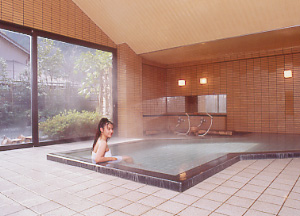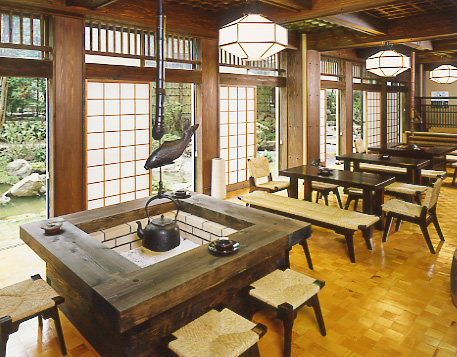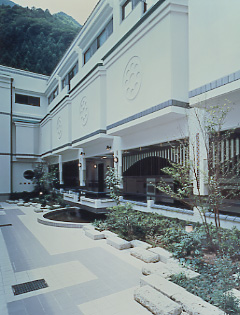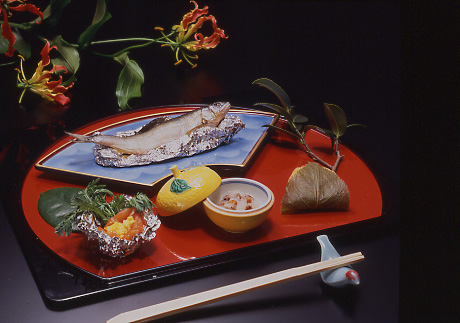|
A Place in the Japanese Soul
Moscow to Beijing via Mongolia The World's Gingseng Capitol Pacific Rim Delux Hotels Guide |
CONTACT US
|
ADVERTISING INFO
© 1996-2013 Asian Media Group Inc
No part of the contents of this site may be reproduced without prior written permission.
ESSENTIAL JAPAN
PAGE 2 OF 3

The indoor public bath receives sunlight through its big picture windows. On the other side of the windows is the outdoor bath. |
Suikoen prepares special things for the guests during this season. Flowers are set in elaborate vases by ikebana, the Japanese flower arrangement art. Arrangements include pines, bamboos, Japanese apricots with silver or gold colored stems. The design of yukatas, towels and soaps are especially colorful this time of year. Rice cakes served with tea in each room are also special in this season. Among them, the most special feature is the New Year's breakfast, osechi ryori, a sumptuous arrangement of a variety of popular Japanese foods that call for good luck that year, and is served in three-layered lacquer boxes called jubako. Originally osechi ryori used to be served in five-layered boxes, but as Japanese society has changed, people tend to devote less time and energy to preparing osechi ryori.

Suikoen's lobby contains a traditional fireplace and furnishings. It offers a delightful view of the garden. |
[CONTINUED BELOW]
Food preparation and presentation are a very important part of Japan's tradition, and at the inn even the smallest detail is carefully planned. The cooks, the okami, and the manager have regular meetings to select the appropriate dishes for each season and to construct aesthetically pleasing dishes that could be considered a work of art. "We chose bright colors for our dishes," says the okami, "but at the same time they can't be too vivid as to overwhelm the original beauty of food." As meals are placed on the table, many guests, including me, take pictures of the dishes while the attendants explain the ingredients and cooking method for each dish.

Suikoen's patio, designed as a modernized Japanese space. The building combines modern materials with the Inn's family crest engraved on the wall. |
I have been lucky enough to know Suikoen and the delicacy of its tastes since I was six years old. Since then, before going there, I always ask the proprietor if they are already serving hotpot deer or boar. She always laughs and says, "I thought it's the season you might call us." In addition, sashimi, raw fish, a Japanese favorite, is also available since there is a famous fishing port named Yaizoku in Shizuoka prefecture which supplies an abundance of fresh fish. The tastes of Suikoen have never betrayed me.
Desserts resemble a minature scene of Sumatakyo's nature. Young guests often ask if they can have another tea mousse pudding and tea jelly, served as desserts with dinner, before leaving the inn. I ws impressed by the sensation of smoothness in my mouth, the sophisticated level of sweetness, and the excellent smell of green tea. The okami brought me to the kitchen and revealed the process of cooking the tea mousse pudding. Two cooks were cooking it from powdered tea, which Japanese use for tea ceremony. The tea is known as Honkawane tea, after the region famous for its green tea.
Radiating outward from Sumatakyo are large green fields, and a common sight on the tea fields is tea pickers wearing straw hats with red string and cotton clothing of light blue and navy blue. During harvest season, the okami explained, her attendants suddenly leave her shorthanded to pick tea leaves in their farms. Rice and tea taste better in Sumatakyo than in Tokyo. I am convinced it's due to the area's water and clean air.

A closeup of the broiled trout. Meals are created using well-planned pairings of foods with the dishes on which they are served. |
Those willing to explore Sumatakyo's surroundings will discover one of the local treasures, an old suspension bridge over the Sumata River called the Bridge of Dreams. The bridge is a walking distance from the village, nestled quietly among nature. The bridge is 230 feet long and only two feet wide. Below it coils the emerald-green waters of the Sumata river. The narrow bridge set deep inside a quiet, bright emerald-green nature is a sight that fills me with a sense of mystery, even a little fear.

Dinner at Suikoen consits of regional dishes including trout, a hotpot of deer or boar with vegetables, flowering ferns and bracken tempura, fried the Japanese way. Deer and boar meat are served by special order from October to February. |
According to legend some visit the bridge not to dream, but to end all dreams. For one who has lost hope, is the next dream to be released from this transient world? Or is it the beauty of the scene that mysteriously seduces them into joining nature permanently? It is a mystery. Local people remember stories about the bridge and recreate vividly past sadness and pain. In an ennvironment where people live a simple life, those incidents echo clearly in the mind for a long time. PAGE 3
|
"The Bridge of Dreams is 230 feet long and only two feet wide. Below it coils the emerald green waters of the Sumata River." |
